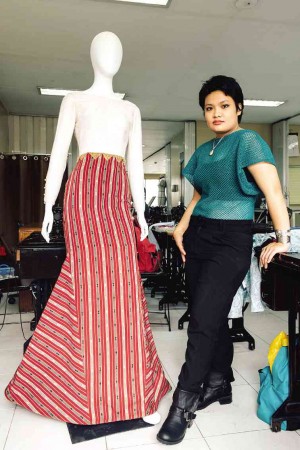
Twenty-two-year-old student designer Nathalie Versoza is very proud of her Ifugao roots, and her heritage plays a major role in her designs.
Quiet and timid, she admits that she can be anti-social at times. “Not to the point that I don’t have any friends, though. I love spending time alone, meditating and thinking.”
People consider her a bit mature for her age. Give her any extremely hard test, and without doubt, she would accept the challenge.
Her interest in making clothes started when she was in grade school. By just observing her older peers, she would see how the clothes were being made.
“I started to have an interest in making clothes when I was a Grade 2 student at Philippine Women’s University-Jose Abad Santos Memorial School. When I joined the theater group, I was drawn to the costumes because they’re different and vibrant.”
Her love of fashion was developed in home economics class. She discovered her passion for creating personalized and specialized designs.
“That was the time I started to make my own stuff leisurely. It went on and on until high school. I got used to hand sewing, and I’ve used only the sewing machine for finishing touches,” she says.
She had to put her design dreams on hold in college. She followed her mom’s wishes—she got her degree in Nursing. But her passion for the arts remained stronger than for any high-paying career.
“After everything, it feels like my heart is still set on fashion. My situation can be compared to that of the merchant in Paolo Coelho’s ‘The Alchemist.’ The merchant at first thought he was contented with his life, but his thoughts were still on how to turn things into gold.”
A passion for Filipiniana
“I’m fighting for local fabrics. I love our fabrics. Seeing them inspires me to create something edgy,” she says.
Working with our homegrown fabrics is a tearful mixture of joy and pain. A young designer’s goal is usually to outshine everyone, to leave a mark on fashion writers and fashion editors.
To work with indigenous fabric was a risky move for a young designer, because it’s not the preferred material of most designers. One wrong move would mean a disastrous output.
Handling the material—a technical aspect—merely challenges her to make it work, at the very least.
No one can deny that fabrics from the northern Philippines are thick and require a huge amount of work. Some just use such fabrics for cover-ups or home décor.
This student-slash-assistant lecturer at Slim’s has added a dimension to traditional Ifugao fabrics. She transformed the traditional wedding wear of Ifugao natives into a modern version of the tribe’s red wedding gown.
Another stellar look is her version of the terno, where she used a purple Ifugao-made textile and added hand-sewn pearls and beading.
She describes herself as a nonconformist designer. She doesn’t like people saying her looks are similar to those of another designer. She is not doing this for the sake of being different, but as a sign of respect to the designs of other people. “I want to be a designer because I want to express what’s in my heart,” she says with a smile.